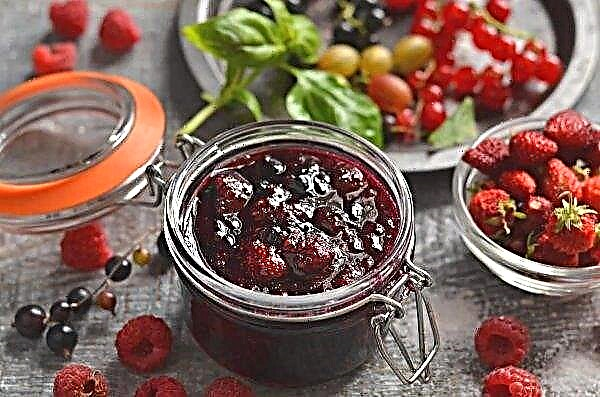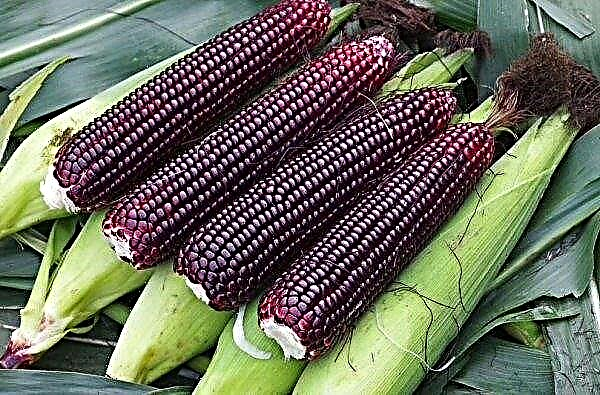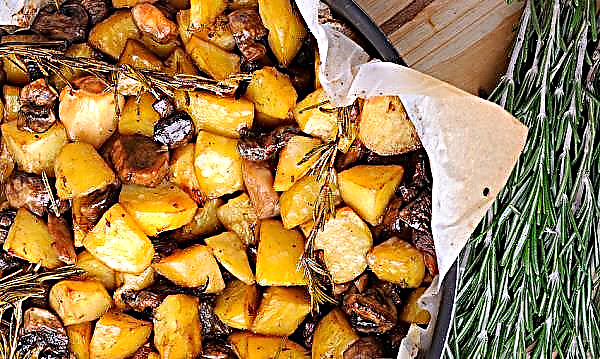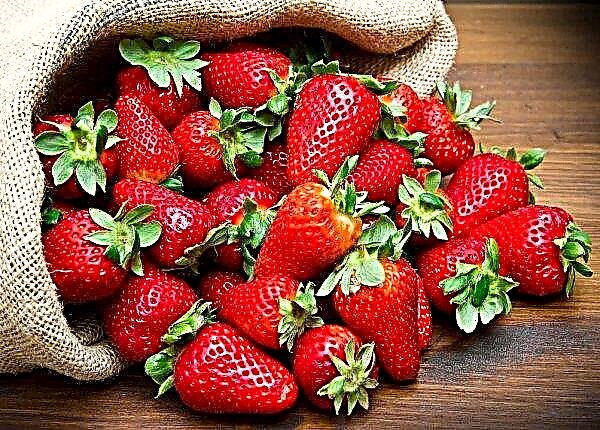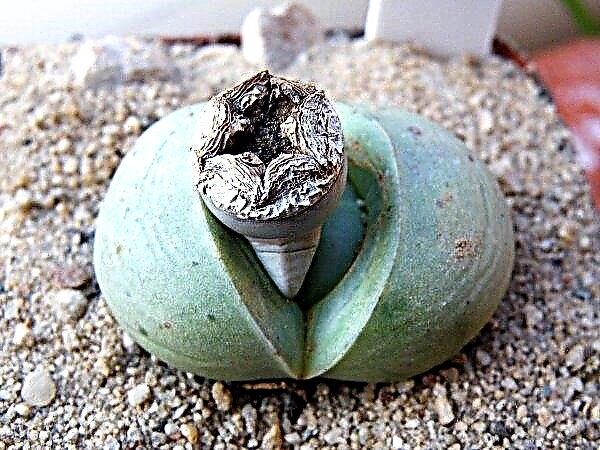Juicy and sweet large berries, which are watermelons, are loved by almost everyone. Therefore, many decide to grow them with their own hands in order to feast on them throughout the season. In the article we will tell you how to grow a crop in the open ground and in the greenhouse, including the features of planting and care, as well as the timing of the harvest and the rules for its storage.
Plant description
Watermelon is an annual plant belonging to the pumpkin family. This culture was grown back in Ancient Egypt, and the sands of the Kalahari desert are considered its homeland. Already in ancient times, people knew what unique properties this plant possesses: although the culture is hygroscopic, in particularly dry periods it is able to remain green without a single drop of watering due to the ability of the root system to find moisture in deeper layers of the soil. Also, the purifying properties of watermelon have been known since ancient times for various diseases of the kidneys and gastrointestinal tract, among which are pancreatitis and cholecystitis.
The described gourds have the following characteristics:
- The berry can have a different shape - cylindrical, round, oval (depending on varietal variety).
- The creeping stalk, creeping (up to 3-4 m), with strong branches, whip branches grow up to 5 m.
- The foliage is pentahedral, coarse, hairy, rough on both sides.
- In the leaf sinuses of the plant, flowers are formed (male ones are usually smaller than female ones).
- The root system is powerful, has great suction power. The main rhizome is located 45–50 cm from the soil surface, and some roots can penetrate to a depth of 3 m or more. Roots form until the flowering period, and then stop growing.
- The culture blooms on the 40-50th day after sowing: first, male flowers open, and after 10-14 days - female flowers. Male watermelon flowers massively bloom on the 65th day, female flowers on the 70–80th.
- Fertilized ovaries form in the form of balls on the main lash and grow intensively in the first period of development.
- The fruits are smooth, in the form of a multi-seeded pumpkin.
- The berries consist of a dense peel, an inner part having a red-pink, very juicy and sweet soft texture, and seeds of ellipsoid shape, of various sizes and colors.
- The fruits grow to different sizes and can be weighing from 1.5 to 10 kg, and with a diameter of 18 to 40 cm or more.
Did you know? There is a variety of watermelon "Moon and Stars." Such an original name is sweet berry received due to its blue-green peel, strewn with yellow spots of different sizes, reminiscent of the starry sky in the night.
The best varieties for planting
Today there are many universal, mid-ripening, mid-early and early ripening varieties of watermelon.
We will tell you what varieties of this plant are considered optimal for growing on our open spaces:
- Lady F1. Berries are oval, in the northern regions grow 5 kg or more, in the southern - 11-18 kg. They have a high (11%) sugar content. Inside intensely colored, flesh without hard veins, with small seeds. The peel is of moderate thickness with smooth and wide covering strips. The variety is suitable for transportation and 1.5-month storage. From 1 ha you can collect over 40 kg of berries.
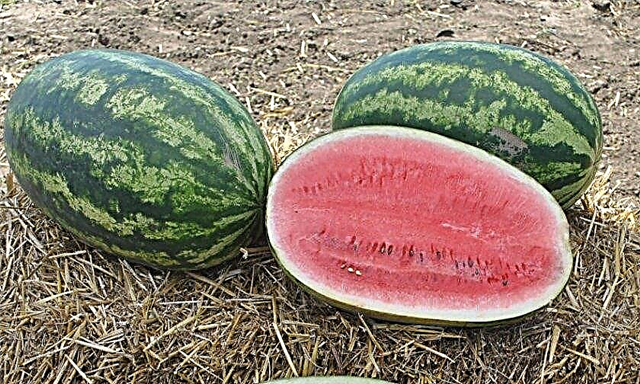
- Eureka F1. The fruits ripen 75 days after sowing the seeds. Watermelons gain weight from 7 to 14 kg (depending on the region). The berries are striped, spherical or slightly elongated, with a strong peel that can withstand transportation and good storage. They have great taste.

- Prince of Denmark F1. Maturing term - 80 days. The watermelons of this hybrid have slightly oblong, spherical fruits with an average weight of 6 kg, sometimes they can grow to huge sizes - from 18 kg or more. Berries have a dark green surface and fuzzy striping. The pulp is deep pink in color, sweet, with small seeds. After harvesting, watermelons can lie for 1 month.

- Crimson Sweet seedless F1. Hybrid, which in the north can bear 4 kg fruits, and in the south or in the greenhouse - much larger, weighing up to 14 kg. Excellent sugar content (5–7%). Watermelons of this variety are somewhat elongated, with uniform stripes, of medium thickness bark. Collection from 1 m² - from 2.5 to 4 kg. Harvest can be stored up to 9 weeks.
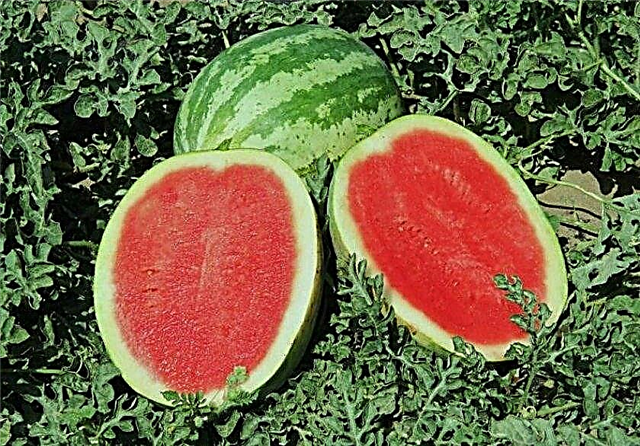
- Krimlong F1. A hybrid variety with beautiful elongated fruits. For a period of less than 3 months, the plant grows berries with good sugar content and weighs up to 10 kg. Fruits with a strong peel that promotes good storage and excellent transport.
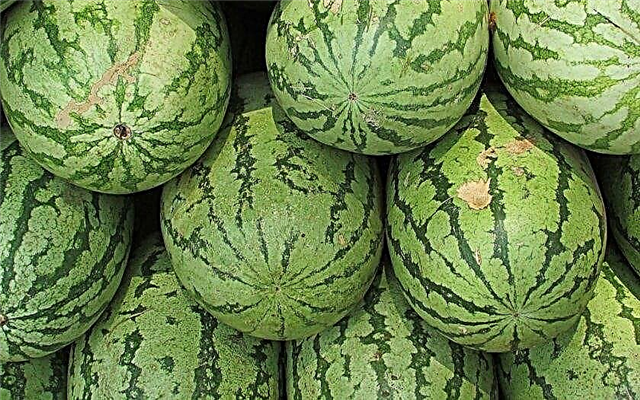
- Striped torpedo F1. The ripening period is 12 weeks. In the middle lane in open ground, fruits can weigh up to 5-12 kg. In the south, non-irrigated land can yield yields of more than 20 kg per 10 m². They have very good sugar content (8%). Berries can be stored for up to 1 month.

- Barrel of honey. Fruits of a beautiful cylindrical shape ripen in 3 months and gain weight from 2.5 to 6 kg. These watermelons have a pinkish sugary flesh and a thick, dense skin. Berries are suitable for transportation. Average fees from an area of 10 m² - up to 15 kg.

- Charleston Gray. The variety has cylindrical fruits with pale light green skin and an implicit, mesh-mosaic depiction. An average watermelon can weigh from 3 to 8 kg, while larger ones can weigh up to 18. Maturation occurs on the 70–90th day. Sugars are within 7%. The yield of these watermelons in the southern regions on irrigated soils is up to 45 kg per hectare. The berries have a moderately thick peel that does not burst during transportation. Products can lie up to 1.5 months.

- Kai F1. The culture is genetically tolerant of colds and poor lighting. The best yields can be achieved under film shelters, where berries can weigh up to 10 kg. A hybrid is best grown not by the natural method, that is, by seeds in open ground, but by seedlings. The culture has a long, actively developing stem, from which ripe berries can be removed on the 70th day after germination. The peel of the berries is thin, and the seeds are small.
Planting seeds for seedlings
Watermelon propagation can be done in the seedling method (especially recommended in regions with a short summer). To do this, prepare seed material, sow it in a suitable container and the right soil.
Seed preparation
Watermelon seeds before planting are prepared as follows:
- Seeds must be wrapped in a wet cloth and placed in water with the addition of several crystals of potassium permanganate (for disinfection) for 15-20 minutes, and then removed and washed under running water.
- After soaking, put the tissue with the seeds in a plastic bag and place it near the heating battery so that they can hatch in the heat.
- To access the oxygen seeds, the packet with them needs to be slightly opened (a couple of times a day).
- After a week, the seeds with the emerged sprouts must be decomposed in peat pots or containers with special soil.
Did you know? In the USA, the “Watermelon Queen” contest is held annually, the winner of which receives a highly paid annual maintenance. Her responsibilities include speaking at various social events advertising the eating of this sweet berry.
Selection of capacity and soil
It is necessary to pay no less attention to the selection of the capacity and composition of the soil for seedlings, since the watermelon does not tolerate diving or transplanting:
- Seedlings should be immediately grown in containers (0.3 l) filled with peat or a special earthen composition.
- The earth mixture should consist of humus soil and peat, with the addition of turf and mineral fertilizers in the form of wood ash or superphosphate (2 tsp per 1 kg of soil).
- You can buy a ready-made soil mixture intended for melons and gourds in a specialized store.

Seed planting
Watermelon seeds are planted according to the following technology:
- The soil in the tanks must be moistened.
- Plant seeds in each container to a depth of 2-3 cm and smooth the surface.
- Put all the containers in a warm place under the film, so that the temperature is kept below + 20 ... + 27 ° C, otherwise the seeds may not rise, and those that have already sprouted will slow down in growth and development.
- After sowing the seeds, the soil must be kept moist all the time, preventing drying out.
- When the first cotyledonous leaves appear, seedlings need to be moved to a cooler room with a temperature of + 18 ... + 20 ° C.
Important! To watermelon bushes branch more strongly, and the berries grow as large as possible, it is necessary to break off the tops of the lashes, on which the ovaries grow.
Watermelon Seedling Care
Next, we will tell you how to care for seedlings of watermelon.
Growing watermelon from seedlings is not difficult, you just need to provide them with the basic conditions:
- Irrigation with warm water (+ 25 ... + 30 ° C).
- Top dressing with nitrogen and phosphorus fertilizers (1 time). Also, before planting seedlings directly on an open bed, they need to be fed with complex fertilizers for berry crops.
- Good lighting, organized using a phytolamp.
- During seedling growth, it is necessary to maintain the temperature regime within + 22 ... + 26 ° C.
- Humidity should be at least 70%.

A month after sowing the seeds, watermelon seedlings (at this point they should already have 3 leaves) can already be planted in open ground in the garden or in the country.
Open transplant
Before planting watermelon seedlings in open ground, you need to know what soil they like. According to experienced gardeners, soils with a neutral reaction and light structure (sandstone or sandstone) are best suited for gourds. It is also important to adhere to certain nuances of their landing.
Plant seedlings according to these rules:Important! Do not deepen the roots of seedlings into the ground, so as not to provoke their rot.
- In the middle and southern strip seedlings are planted in late spring (second half of May) or in early June.
- Land for seedlings should be well fertilized since the fall (phosphate-potassium fertilizers, organic matter, wood ash or dolomite flour are added for digging).
- The place for beds under watermelons is chosen taking into account the absence of their blowing by strong winds and drafts, preferably in the south or southeast of the site.
- In early spring, make high ridges up to 15 cm high, with a slope to the south (for a good outflow of excess fluid down the bay and better warming up the soil). The width of the ridges is 85 cm, the length is not less than 4 m. A half-meter layer of rotted manure is laid on the bottom.
- On the plot with seedlings, an unacceptably close occurrence of groundwater is unacceptable.
- Seedlings are planted on ridges, making holes 6 cm deep in them, into which small bushes carefully carefully removed from the containers are put together with an earthen lump. The distance between each plant should be at least 80 cm.
- Arcs are installed above the seedlings and a film shelter is placed on them.
- After the emergence of viable lashes in seedlings, the shelter is removed (subject to a stably high air temperature).

Features of outdoor care
Care for watermelon seedlings planted in open ground includes:
- proper irrigation regimen;
- timely and appropriate top dressing;
- protection from scorching sunlight;
- elimination of diseases and parasites.
Watering
Since watermelons have a root root extending more than 1 m deep into the earth, and the root appendages occupy the upper layers of the soil, seedlings after planting need to be abundantly, but not too often watered, pouring 30–35 liters of water on 1 m² of land. During the flowering period, watering is carried out at least 2 times a week, and when the harvest ripens, the irrigation is stopped altogether.
Top dressing
With the formation of lashes in seedlings, you need to feed them with such fertilizing (optional):
- solution of chicken droppings (1 kg of droppings + 20 l of water);
- a solution of cow manure (1 kg of manure + 8 l of water);
- also during this period, plants are given mineral fertilizers in the form of superphosphate.

Sun protection
So that sweet berry seedlings do not suffer from the scorching sun, it is recommended that they organize protection in the form of shelters.
These include:
- Individual or group film shelters laid on arcs. Such shelters make it possible to bring crop ripening closer to 2-3 weeks due to an increase in the microclimate temperature under the film, and also prevent the entry of burning rays on the delicate foliage of plants, but also cold air during possible late frosts. They also serve as a barrier to the development of various infections and the penetration of harmful insects.
- Tunnel, in the form of a frame made of twigs or wire rod. Such frames well shade the leaves of watermelons from the sun, but do not isolate plants from the cold and do not interfere with diseases and pests to get to the young plantings.
Pest and Disease Control
If you have made all the necessary efforts to grow watermelons from seedlings, but they still do not grow - perhaps the reason for this is pests and diseases of melons.
Here are some of them:
- Fusarium It affects the lashes of an adult plant. On the roots, small reddish spots with a pink coating first appear. In the process of further development of the disease, the culture rots. If the first signs of damage are detected, the bush and soil must be treated with a mixture of equal parts of colloidal sulfur and wood ash. If the disease has been actively developed, fungicidal preparations are used (Previkur Energy, Fitosporin).

- Anthracnose. A sign of defeat is the appearance both on the leaves and on the stems and berries of blurry spots of a yellowish-brown color, covered with pink warts. Subsequently, black ulcers appear, the leaves dry out, and the fruits rot. If the first symptoms are found, the bushes are sprayed with Kuprozan, Tsineb or Bordeaux liquid. If the disease was discovered late, all affected bushes are weeded out and burned, and the soil is disinfected with a 2% solution of iron sulfate.

- Root rot. The disease is characterized by the appearance of brown-black wetting spots, yellowing of the leaves, cracked and scattered roots. Sometimes mold appears, expressed by an unpleasant odor of the soil. With the onset of primary symptoms, the disease is treated with copper sulfate. The neglected stage is not treated - the affected plants are removed and burned.
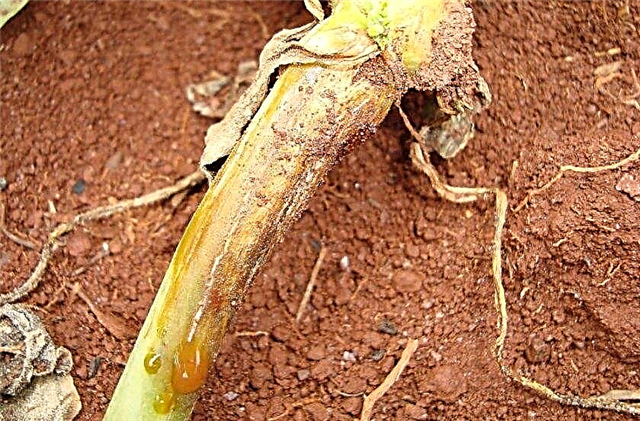
- Gourd aphids. The plant is affected by entire colonies of parasites, which cling to almost the entire bush and thereby form a black coating on it. You can process bushes with infusions from plants that have a strong aroma. To do this, use garlic, wormwood, onions, citrus peels. In order to prevent aphids, spicy herbs are planted near the plantations of watermelons.

- Spider mite. From this parasite for the purpose of prevention, the treatment of bushes with infusions on onion or garlic gruel helps. When a pest appears, only chemicals (Apollo, Agravertin) will be effective.
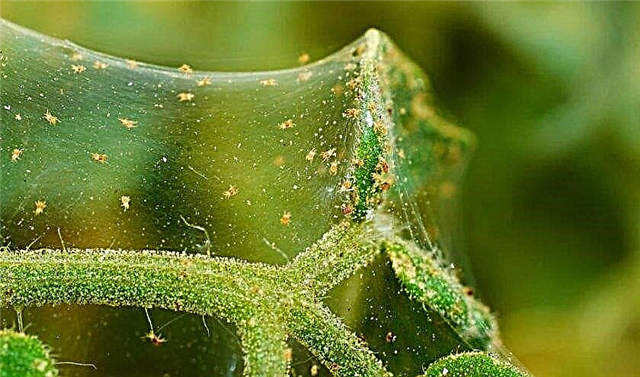
- Wireworms. The roots of melons and gourds are damaged by parasites, less often the fruits themselves. They are dangerous in that they can tolerate many fungal diseases. To prevent the appearance of parasites during soil preparation, dolomite flour, ground egg shells or wood ash are added.

Features of growing watermelons in a greenhouse
Growing striped berries in a greenhouse is somewhat different from growing crops in open beds:
- If watermelon seedlings can be planted in open ground only at persistent high temperatures, when the threat of night frosts has gone (late May - early June), then berries are planted in the greenhouse in the second decade of May.
- 20-day-old seedlings are planted in a greenhouse, while seedlings of 30–35-day-old are planted in open soil.
- Another difference between greenhouse growing watermelons is that the plants in this case need to be tied to supports in the form of trellises (due to space saving and the ability to plant more bushes per 1 m²): watermelon lashes are tied to a stretched length of 35 cm in several rows of wire, placing the bush from the bush 40 cm from each other (in the garden - not less than 80). All lashes, flowers and ovaries below 35 cm are removed (count from the root necks of the bushes).
- In greenhouse conditions, fruits need moderate watering and lowered air humidity (60%) before ripening, while plentiful watering and a humidity level of not more than 70% are required for an open watermelon bed.
- Harvest dates for greenhouse melon crop agricultural technology also differ significantly: in the garden or in the field, sweet berries are harvested 2-3 weeks later than in the greenhouse crop.
- Due to the space limited by the size of the greenhouse, the spread of diseases does not occur, while garden crops are more prone to such problems.
- With the greenhouse content of watermelons, their natural pollination by insects is almost impossible, and in the open ground, insects have free access to watermelon flowers.
Important! It is imperative that the plywood or plastic linings be placed under the watermelon fruits - this way the berries will not come into contact with the ground.
Here are some more features of growing watermelons in greenhouses:
- the daytime temperature in the greenhouse should be + 26 ... + 28 ° C, night - + 18 ° C;
- watermelon seedlings in the greenhouse should be planted on ridges located in beds made along stretched trellises; ridges 60–70 cm wide and 25 cm high; ridges at the base 40 cm wide and up to 20 cm high;
- holes for seedlings are made up to 8 cm deep;
- the fruits are formed on the main lash: 2 to 6 ovaries are left on 1 bush, and the rest are removed in order not to overload the plant;
- in a greenhouse for large-fruited watermelon species, ovaries with a diameter of 10 cm are placed in special nets that are tied to trellises.
Video: The intricacies of growing watermelons in a greenhouse
Harvest dates and storage rules
Harvesting watermelons should be determined by the signs of their ripeness:
- Before the harvest begins, the berries must ripen in the field, because watermelons that are torn before the set deadlines will never have a full color of pulp and the necessary taste.
- Watermelons can be consumed when the flesh becomes sweet and crisp, bright red in color (although there are some types and hybrids with light red and even yellow flesh).
- Although it is impossible to determine the ripeness of a berry without cutting it and tasting it, experienced farmers can determine the ripeness of watermelon by such external indicators:
- dried antennae and stipules near the stalks;
- change in the color of the skin or wax coating on it;
- soil stain of intense yellow color;
- a certain (sonorous) sound when tapping the fetus.
- The best way to determine the ripeness of watermelons is by seed: if up to 95% of the seeds are ripe (have a color characteristic of the variety), then the fruits can be harvested.
- Important indicators of total sugar content. To determine the ripeness of the fruit, you need to select several copies on the field in an arbitrary order and taste the flesh. Also, the sugar content is determined by a refractometer. The indicator of the suitability of fruits for mass consumption should border at the level of 10% or more. If among the samples taken for the sample all were ripe, then the remaining fruits will also be ripe.

When laying the harvested fruits, one should be guided by the following factors:
- Berries must be consumed in the first 2-3 weeks after harvesting from the field, otherwise the crisp structure of the pulp in the watermelon will be lost.
- The optimum temperature regime for fruit storage is + 10 ... + 15 ° С.
- The optimum humidity in the room is 85–90%.
- It is also important to remember that for long-term transportation the fruits are harvested to such a degree of ripeness when they are not yet fully ripe. This will help prevent loosening of the fruit pulp during transport.
When choosing a method of planting watermelons in your garden, you need to take into account your climate zone and the weather forecast for the next 3 months. It is also important to choose a suitable sweet berry variety, and then collect the crop on time and properly preserve it.



















